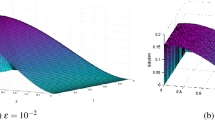Abstract
We describe the time discretization of a three-dimensional baroclinic finite element model for the hydrostatic Boussinesq equations based upon a discontinuous Galerkin finite element method. On one hand, the time marching algorithm is based on an efficient mode splitting. To ensure compatibility between the barotropic and baroclinic modes in the splitting algorithm, we introduce Lagrange multipliers in the discrete formulation. On the other hand, the use of implicit–explicit Runge–Kutta methods enables us to treat stiff linear operators implicitly, while the rest of the nonlinear dynamics is treated explicitly. By way of illustration, the time evolution of the flow over a tall isolated seamount on the sphere is simulated. The seamount height is 90% of the mean sea depth. Vortex shedding and Taylor caps are observed. The simulation compares well with results published by other authors.










Similar content being viewed by others
References
Adcroft A, Hill C, Marshall J (1997) Representation of topography by shaved cells in a height coordinate ocean model. Mon Weather Rev 95:2293–2315
Ascher UM, Ruuth SJ, Spiteri RJ (1997) Implicit–explicit Runge–Kutta methods for time-dependent partial differential equations. Appl Numer Math 25:151–167
Ascher UM, Ruuth SJ, Wetton BT (1995) Implicit–explicit methods for time-dependent partial differential equations. SIAM J Numer Anal 32:797–823
Blaise S, Comblen R, Legat V, Remacle J-F, Deleersnijder E, Lambrechts J (2010) A discontinuous finite element baroclinic marine model on unstructured prismatic meshes. Part I: space discretization. Ocean Dyn (in this issue)
Blumberg AF, Mellor GL (1987) A description of three-dimensional coastal ocean circulation model. In: Heaps NS (ed) Three dimensional coastal ocean model. American Geophysical Union, Washington, DC, pp 1–16
Bryan K (1969) A numerical method for the study of the circulation of the world ocean. J Comput Phys 4:347–376
Chapman DC, Haidvogel DB (1992) Formation of Taylor caps over a tall isolated seamount in a stratified ocean. Geophys Astrophys Fluid Dyn 64:31–65
Chapman DC, Haidvogel DB (1993) Generation of internal lee waves trapped over a tall isolated seamount. Geophys Astrophys Fluid Dyn 69:33–54
Chevaugeon N, Hillewaert K, Gallez X, Ploumhans P, Remacle J-F (2007) Optimal numerical parametrization of discontinuous Galerkin method applied to wave propagation problems. J Comput Phys 223:188–207
Cockburn B, Shu C-W (2001) Runge–Kutta discontinuous Galerkin methods for convection-dominated problems. J Sci Comput 16:173–261
Cushman-Roisin B (1994) Introduction to geophysical fluid dynamics. Prentice Hall, New York
Deleersnijder E (1993) Numerical mass conservation in a free-surface sigma coordinate marine mode with mode splitting. J Mar Syst 4:365–370
Dukowicz JK, Smith RD (1994) Implicit free-surface method for the Bryan–Cox–Semtner ocean model. J Geophys Res 99:7991–8014
Dukowicz JK, Smith RD, Malone RC (1993) A reformulation and implementation of the Bryan–Cox–Semtner ocean model on the connection machine. J Atmos Ocean Technol 10:195–208
Ford R, Pain CC, Piggott M, Goddard A, de Oliveira CR, Umpleby A (2004) A non-hydrostatic finite element model for three-dimensional stratified oceanic flows, part II: model validation. Mon Weather Rev 132:2832–2844
Giraldo FX, Perot JB, Fischer PF (2003) A spectral element semi-Lagrangian (SESL) method for the spherical shallow water equations. J Comput Phys 190:623–650
Griffies SM, Böning C, Bryan FO, Chassignet EP, Gerdes R, Hasumi H, Hirst A, Treguier A-M, Webb D (2000) Developments in ocean climate modeling. Ocean Model 2:123–192
Hallberg R (1997) Stable split time stepping schemes for large-scale ocean modeling. J Comput Phys 135:54–56
Higdon RL, de Szoeke RA (1997) Barotropic–baroclinic time splitting for ocean circulation modeling. J Comput Phys 135:30–53
Huppert HE, Bryan K (1976) Topographically generated eddies. Deep-Sea Res 23:655–679
Johnson ER (1984) Starting flow for an obstacle moving transversely in a rapidly rotating fluid. J Fluid Mech 149:71–88
Killworth PD, Stainforth D, Webb DJ, Paterson SM (1991) The development of a free-surface Bryan–Cox–Semtner ocean model. J Phys Oceanogr 21:1333–1348
Kubatko E, Dawson C, Westerink J (2008) Time step restrictions for Runge–Kutta discontinuous Galerkin methods on triangular grids. J Comput Phys 227:9697–9710
Marshall JC, Adcroft AJ, Hill CN, Perelman L, Heisey C (1997) A finite-volume, incompressible Navier Stokes model for studies of the ocean on parallel computers. J Geophys Res 102:5753–5766
Verron J, Le Provost C (1985) A numerical study of quasi-geostrophic flow over isolated topography. J Fluid Mech 154:231–252
Wang Q (2007) The finite element ocean model and its aspect of vertical discretization. Ph.D. thesis, Bremen University
Wang Q, Danilov S, Schröter J (2008) Finite element ocean circulation model based on triangular prismatic elements, with application in studying the effect of topography representation. J Geophys Res 113:C05015
White L, Legat V, Deleersnijder E (2008) Tracer conservation for three-dimensional, finite-element, free-surface, ocean modeling on moving prismatic meshes. Mon Weather Rev 136:420–442
Williamson DL, Drake JB, Hack JJ, Jakob R, Swarztrauber PN (1992) A standard test set for numerical approximations to the shallow water equations in spherical geometry. J Comput Phys 102:211–224
Acknowledgements
Sébastien Blaise and Jonathan Lambrechts are research fellows with the Belgian Fund for Research in Industry and Agriculture (FRIA). Richard Comblen is a research fellow with the Belgian National Fund for Scientific Research (FNRS). Eric Deleersnijder is a research associate with the Belgian National Fund for Scientific Research (FNRS). The research was conducted within the framework of the Interuniversity Attraction Pole TIMOTHY (IAP 6.13), funded by the Belgian Science Policy (BELSPO), and the programme ARC 04/09-316, funded by the Communauté Française de Belgique.
Author information
Authors and Affiliations
Corresponding author
Additional information
Responsible Editor: Pierre Lermusiaux
Rights and permissions
About this article
Cite this article
Comblen, R., Blaise, S., Legat, V. et al. A discontinuous finite element baroclinic marine model on unstructured prismatic meshes. Ocean Dynamics 60, 1395–1414 (2010). https://doi.org/10.1007/s10236-010-0357-4
Received:
Accepted:
Published:
Issue Date:
DOI: https://doi.org/10.1007/s10236-010-0357-4




